
Centime is French for "cent", and is used in English as the name of the fraction currency in several Francophone countries.
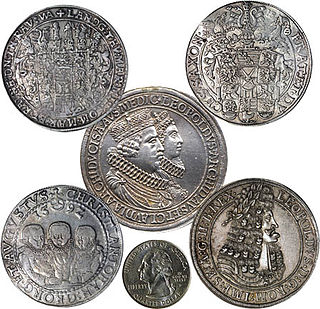
A thaler or taler is one of the large silver coins minted in the states and territories of the Holy Roman Empire and the Habsburg monarchy during the Early Modern period. A thaler size silver coin has a diameter of about 40 mm and a weight of about 25 to 30 grams. The word is shortened from Joachimsthaler, the original thaler coin minted in Joachimsthal, Bohemia, from 1520.
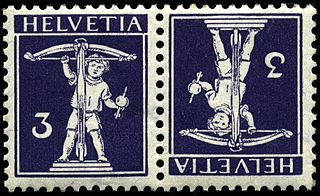
This is a survey of the postage stamps and postal history of Switzerland.

The Swiss franc, or simply the franc, is the currency and legal tender of Switzerland and Liechtenstein. It is also legal tender in the Italian exclave of Campione d'Italia which is surrounded by Swiss territory. The Swiss National Bank (SNB) issues banknotes and the federal mint Swissmint issues coins.

The franc, also commonly distinguished as the French franc (FF), was a currency of France. Between 1360 and 1641, it was the name of coins worth 1 livre tournois and it remained in common parlance as a term for this amount of money. It was reintroduced in 1795. After two centuries of inflation, it was redenominated in 1960, with each new franc (NF) being worth 100 old francs. The NF designation was continued for a few years before the currency returned to being simply the franc. Many French residents, though, continued to quote prices of especially expensive items in terms of the old franc, up to and even after the introduction of the euro in 2002. The French franc was a commonly held international reserve currency of reference in the 19th and 20th centuries. Between 1998 and 2002, the conversion of francs to euros was carried out at a rate of 6.55957 francs to 1 euro.
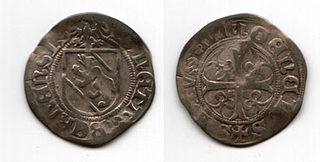
The batzen is an historical Swiss, south German and Austrian coin. It was first produced in Bern, Switzerland, from 1492 and continued in use there until the mid-19th century.
The Congolese franc is the currency of the Democratic Republic of the Congo. It is subdivided into 100 centimes. However, centimes no longer have a practical value and are no longer used. In April 2024, 2,800 francs was equivalent to US$1.
The dinar is the monetary currency of Algeria and it is subdivided into 100 centimes. Centimes are now obsolete due to their extremely low value.
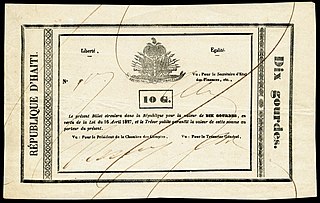
The gourde or goud is the currency of Haiti. Its ISO 4217 code is HTG and it is divided into 100 centimes (French) or santim (Creole).

The Belgian franc was the currency of the Kingdom of Belgium from 1832 until 2002 when the euro was introduced. It was subdivided into 100 subunits, each known as a centiem in Dutch, or centime in French and German.

Vreneli is the informal name for a range of legal tender gold coins of the Swiss franc. The coins were issued between 1897 and 1936, in 1947 and in 1949. All coins issued after 1936 are restrikes.

The Swiss franc has been the currency of Liechtenstein since 1920. The Swiss franc is legal tender since Liechtenstein is in a customs and monetary union with Switzerland. The 1980 treaty between Switzerland and Liechtenstein allows Liechtenstein to mint limited amounts of Swiss francs with a Liechtenstein inscription, but only in the form of commemorative coins, and they are not allowed to issue banknotes.
The Basel frank was the currency of the Swiss canton of Basel between 1798 and 1850. It was worth 1⁄4th the French silver écu or 6.67 g fine silver.

The Berne Thaler was a coin equivalent to the French silver écu issued by the Swiss Canton of Bern. It contained 26.67 g fine silver and was valued at 4 livres.
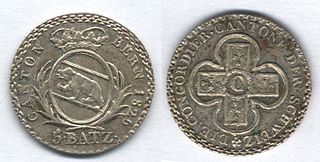
The Frank was the currency of the Swiss canton of Bern between 1798 and 1850. It was subdivided into 10 Batzen, each of 10 Rappen. It was worth 1⁄4th the French silver écu or 6.67 g fine silver.

The Frank was the currency of the Swiss canton of Luzern between 1798 and 1850. It was subdivided into 10 Batzen, each of 10 Rappen or 20 Angster. It was worth 1⁄4th the French silver écu or 6.67 g fine silver.
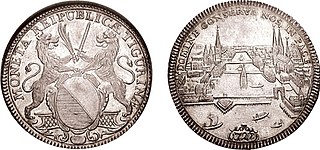
The cantons of the Old Swiss Confederacy used a currency system consisting of based on the old unit of the Schilling, with the Schilling divided into 4 Rappen or 12 Haller. The Taler was a large silver coin equivalent to 72 Schilling or 2 Gulden that came into use in the 16th century. The Batzen was an intermediate coin equivalent to 2 Schilling or 1⁄18Gulden.

The Frank was the currency of the Swiss canton of Zürich between 1806 and 1850. It was subdivided into 10 Batzen, each of 10 Rappen, with 3 Heller to the Rappen and 4 Rappen to the Schilling. It was worth 1⁄4th the French silver écu or 6.67 g fine silver.

The coins of the Swiss franc are the official coins used in Switzerland and Liechtenstein. The name of the subunit is centime in French and internationally, Rappen in German, centesimo in Italian, and rap in Romansh. There are coins in denominations of 5 centimes, 10 centimes, 20 centimes, 1⁄2 franc, 1 franc, 2 francs, and 5 francs.

Christian Fueter was a Swiss medalist and mint-master at Bern from 1792–1837.



















